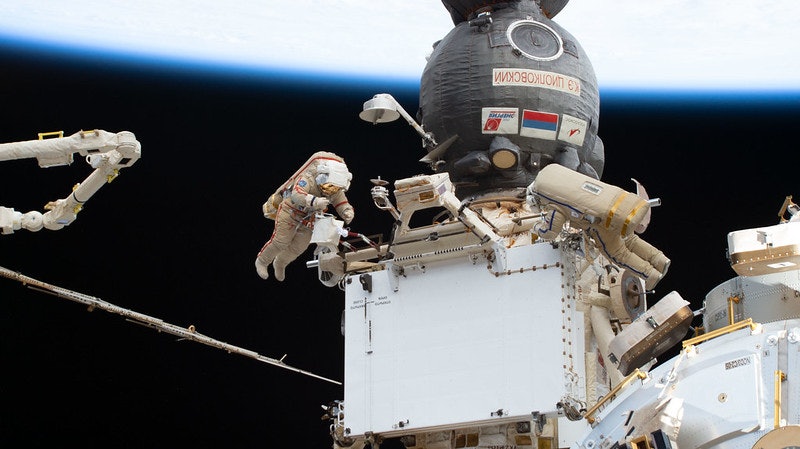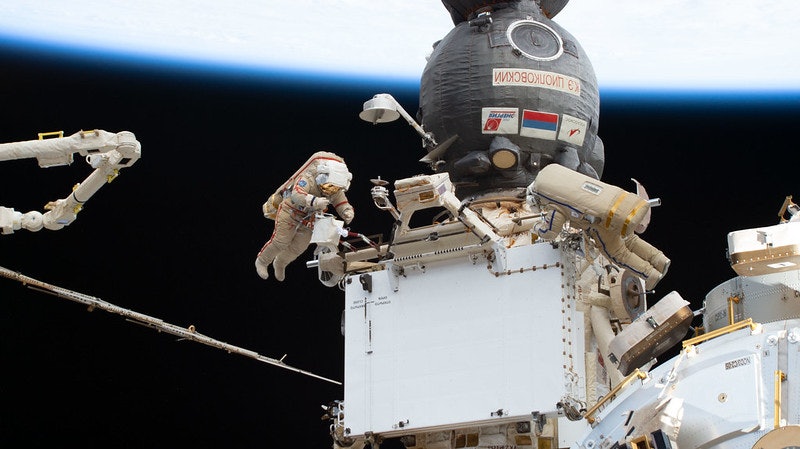
When NASA broadcasts highlights from the International Space Station, they often go on without a hitch. But a rare anomaly played out last week in front of the station’s cameras: Just hours before a spacewalk was set to occur, the ISS experienced a dramatic coolant leak.
Space station cameras witnessed coolant spraying out from the Russian crew capsule Soyuz MS-22 on December 14. The spacecraft, which can carry three people, had ferried two Russian cosmonauts and one NASA astronaut to the ISS in September. It has remained parked at the station’s Rassvet module because the spacecraft is scheduled to bring that same trio back to Earth in March of 2023.
The leak has raised concerns about how the spacefarers will return home next year, according to a NASA press conference on Thursday, which also included leaders from the Russian space agency Roscosmos. It runs the ISS along with NASA.

Evaluating the Soyuz
“We are doing analysis and assess[ing] the risk for a nominal reentry, and [will] determine if reentry [is] dangerous or not safe,” Sergei Krikalev, executive director of Human Space Flight Programs at Roscosmos, told reporters via teleconference on Thursday.
Krikalev added that if MS-22 shows signs that it won’t offer cosmonauts Sergey Prokopyev, Dmitri Petelin, and NASA astronaut Frank Rubio a safe reentry through Earth’s atmosphere, Russia will send an uncrewed Soyuz up to the space station in March 2023.
A day and a half after the leak appeared, Roscosmos flight controllers ran a test of MS-22’s thrusters. “The systems that were tested were nominal… temperatures and humidity within the Soyuz spacecraft, which remains docked to the Rassvet module, are within acceptable limits,” according to a NASA blog post published on December 16.
Meteor shower likely not to blame
On December 18, a Canadian robotic limb on the ISS called Canadarm2 allowed officials to observe a small hole on the Soyuz’s exterior, another NASA blog post says.
It’s possible micrometeoroid debris punched a hole, but NASA and Roscosmos will need to get a better look before determining if the leak is the result of a tiny fast-flying piece of debris or a hardware malfunction.
There was a single hole, NASA’s ISS program manager Joel Montalbano said on Thursday.
Some speculated the Geminid meteor shower was to blame. “Right now, we haven’t confirmed that it’s an MMOD [micrometeoroid and orbital debris] or some other type of failure,” Montalbano said. They did look at the meteor shower that was occurring, and both the trajectory team at NASA’s Johnson Space Center in Houston and the trajectory team in Moscow confirm it was not from the meteor showers. “It was in the wrong direction,” he said.
A new hurdle for spacewalking
Spacewalks stopped until space agencies could conclude the environment outside the ISS was safe. On Thursday, Montalbano said that the leaked coolant boiled off and left no contaminants on the ISS. So, NASA gave a green light for its spacewalk originally scheduled for Wednesday.
“That was a discussion we had before the spacewalk, and the teams have looked at it, and there’s no issue with contamination,” he said.
But Wednesday’s spacewalk actually got underway on Thursday. As NASA astronauts Josh Cassada and Rubio were preparing for the procedure, they had to stop. The ISS had to dodge Russian space debris, triggering the postponement.







